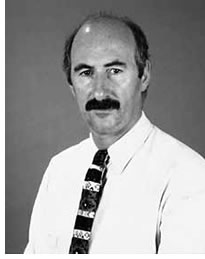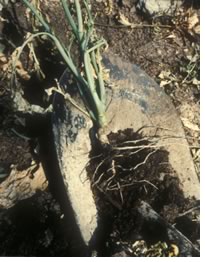

06/2005
An interview with Niall G. Kirkwood, Professor and Chair, Department of Landscape Architecture, Harvard Graduate School of Design
 According to the Ecological
Engineering Group’s Web site, “Phytoremediation combines
the Greek word ‘phyton’, (plant), with the Latin word ‘remediare’,
(to remedy), to describe a system whereby certain plants, working together
with soil organisms, can transform contaminants into harmless and, often,
valuable forms. This practice is increasingly used to remediate sites
contaminated with heavy metals and toxic organic compounds.” AIArchitect interviewed Professor Niall G. Kirkwood, chair of the Harvard Graduate
School of Design’s landscape architecture department and founder
and director of the Center for Environment and Technology, an education
initiative at the GSD that focuses on site analysis, remediation, and
sustainable reclamation issues, about this promising technique.
According to the Ecological
Engineering Group’s Web site, “Phytoremediation combines
the Greek word ‘phyton’, (plant), with the Latin word ‘remediare’,
(to remedy), to describe a system whereby certain plants, working together
with soil organisms, can transform contaminants into harmless and, often,
valuable forms. This practice is increasingly used to remediate sites
contaminated with heavy metals and toxic organic compounds.” AIArchitect interviewed Professor Niall G. Kirkwood, chair of the Harvard Graduate
School of Design’s landscape architecture department and founder
and director of the Center for Environment and Technology, an education
initiative at the GSD that focuses on site analysis, remediation, and
sustainable reclamation issues, about this promising technique.
AIA: How applicable is phytoremediation on a large scale to the design
industry?
NGK: At the present moment it would
still be considered an innovative technology, that is, it’s still
in its experimental stage. It has gone from being quite a marginal or
extreme technology to becoming much more mainstream in the last five
years. I expect in the next 5–10 years, as the science improves and as
there are more applicable sites where it can be used, that it will actually
become much more used by professionals. The way that technologies have
often come into being is that they go through a period of testing and
the need for regulatory approval. This happens first in the laboratory
and then test lots and then in-field testing. Only then does it go into
full-scale industrial production. That takes time.
AIA: How ready do you think governmental and corporate entities are
to embrace phytoremediation?
NGK: Well, it’s interesting that most of the research is being
done by either regulatory authorities—the Environmental Protection
Agency, the DoD on military bases, and large corporations such as Johnson & Johnson,
Exxon, and Chevron—who are spending a lot of time and resources
in research in this area.
AIA: Is it being used primarily for removing metals from the soil or
for other types of industrial contaminants as well?
NGK: It’s being used for a range of contaminants: metals, as you
say. It’s also being used to intercept groundwater plumes and in
landfill capping. I know that there are a number of people who are using
phytoremediation in conjunction with wetlands or storm-water management
to clean up discharges of water and industrial waste products. They are
usually done on a fairly small scale. There still needs to be more testing
to get results, particularly over a longer period of time.
AIA: When this technology is used,
do the plants themselves become toxic, and what effect does it have
on the wildlife?
NGK: Well, there are really four major ways in which contamination passes
into, through, or from plants. The first is simply that plants and the
root host microbial activity that breaks down the contaminants, so it’s
not the plant itself. It’s the plant being a host to small micro-organisms.
The second method is where the plant’s root structure uptakes contaminants and breaks them down. There’s another way where the contaminants go up through the stem, into the leaves, and are held there. That’s actually the case in metal. Metals like lead and zinc are held in the plant and the plants are then harvested with appropriate controls and in proper facilities. In fact, it requires another process. So what the plants do is move the metals from a state in the ground—usually in the top 18 inches of soil—to another state. Remember, you cannot break down an element, which is finite. Although they can be put into other forms molecularly, they cannot be destroyed.
The final method is where volatile organic compounds—carbon-based contaminants commonly known as VOCs—move through the roots, stem, and leaves and are transpired through the pores in the leaves.
 AIA: How do they harvest the plants?
AIA: How do they harvest the plants?
NGK: They tend to incinerate them
under proper facilities with scrubbers and things. There have been cases
I’ve read about where some
of the metals were actually recovered, but this should not be overemphasized
as it will be more of a possibility in the future. In fact, I believe
in Latin America, they’re harvesting metal by cutting trees—such
as rubber trees—or collecting the sap to retrieve ore from the
ground. Although this is not totally substantiated, if you read about
the gold rush in California, certain plants were thought to be indicators
of veins of ore. But again, these plants themselves are simply doing
a task.
There are some plants called hyper-accumulators—say brassica or mustard—that have an ability to take up vast quantities of a metal, beyond what they need in their normal growing process. So, in terms of the wildlife chain, what happens if an animal or an insect or a bird eats the plant? There are two ways to answer that. First of all, the research is not far enough along to know. But, for example, in poplar trees which take up VOCs, very few insects and birds are attracted to poplar, apart from grouse. And then, of course, there are plants themselves that are doing this naturally so it’s already in the food chain. So, at the present moment, unless there are animals that are consuming vast quantities of the polluted vegetation, it is not seen as an issue yet, though I have to caution that not enough research is being done to really understand the process. It should be pointed out that the science of how contaminants move through the plant is continuing to be understood.
AIA: How many years do you think it will take until this is an established
practice?
NGK: I think that each year it’s making great leaps. I remember
going to conferences in 1994 where there were discussions about taking
this technology out of the laboratory and into field testing—very
modest amounts of testing. There have been cases where the testing is
being applied within industrial conditions on development or planning
projects, so that’s actually moved quite far. Of course, we always
look to other countries, particularly those outside our regulatory approval,
like in Europe. And in Asia, where they’ve been able to start phytoremediation
projects, it’s very interesting to look at the results. There’s
a lot of research in Germany now, and some research in Britain and Scandinavia.
One other thing to think about is that this remediation is actually climate-specific because of the plants themselves. Even within the United States, phytoremediation in Alaska is very different than in New Mexico, which is part of its benefit and also part of its problem. I also think it’s really worth mentioning that there is a fledgling industry developing now with a number of dedicated firms that are doing phytoremediation, usually created as an outshoot of university programs.
AIA: What do you think is the biggest obstacle to making phytoremediation
a mainstream practice down the road?
NGK: It’s actually regulatory approval—being able to bring
on board local, state, and federal requirements for remediation procedures.
In some cases, in the Northeast, for example, there’s great interest
via the regulatory approval people because it’s seen as part of
a broader sustainable strategy for dealing with urban brownfields where
we have longer time spans because there is not a need to reuse the site
right away. Also, there is the perception that phytoremediation is more
benign than using extreme engineering solutions, such as hauling away
all the soil or using extraction, vacuum systems, or vitrification.
AIA: How will phytoremediation rate in cost-effectiveness when you factor
in the length of time necessary to remediate the soil?
NGK: It actually is very, very cost effective. It probably has continued
to drive people’s interest over the long term because it will be
very cost-effective. What interests me is the notion of projects that
need to have the green infrastructure built in, where one can actually
use phytoremediation for the cleanup and leave the vegetation in place
to form a structure for long-term programs and uses. For example, they
could put in vegetation that will eventually become parts of streets,
parks, open spaces, or gardens.
AIA: In the client-driven, build-as-quickly-and-cheaply-as-possible
atmosphere that we have today, how viable an alternative is it going
to be for the client, given the length of time necessary?
NGK: I think if you look at it
in terms of cold finance, if a project has to be done very fast, phytoremediation
is not suitable. However, there are clients with projects that will be
phased over time—larger
urban projects. Phytoremediation would be much more applicable for the
later phases of a project—Phases 3, 4, and 5.
The other thing that I’m finding clients very interested in is the publicity or the ethos it creates for the project. It suggests, along with other issues related to say LEED™ standards and to sustainable approaches to planning and design, that it is part of a larger narrative or story that clients are building about how they’re treating and addressing the site. So, in a sense, you could use it to make a point about how sustainable the client is. That sometimes is more marketing and hype than reality, but, on the other hand, some people are very earnest and serious about this and are seeing it as a useful part of a broader approach to development.
Copyright 2005 The American Institute of Architects.
All rights reserved. Home Page ![]()
![]()
 |
||
The GSD Web site enumerates seminars, lecture courses, and design studios ascribed to Professor Kirkwood. They include: Technology in Landscape Architecture; Land Reclamation and Remediation Technologies; Brownfield Practicum: Sustainable Redevelopment of Brownfield Sites in Dorchester and East Boston, Mass.; Rebuilding Devastated Landscapes: Sustainable Landscape Development in the 21st Century; and Planning and Design of Landscapes. Publications Weathering and Durability in Landscape Architecture (John Wiley & Sons, Inc., 2004). Manufactured Sites: Rethinking the Post-Industrial Landscape (Spons Architecture Price Book, August, 2001).
|
||